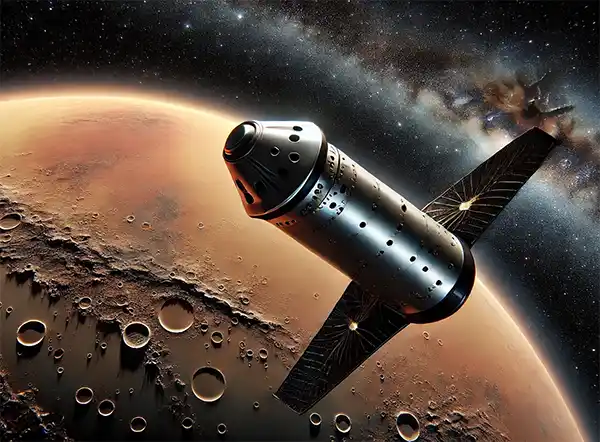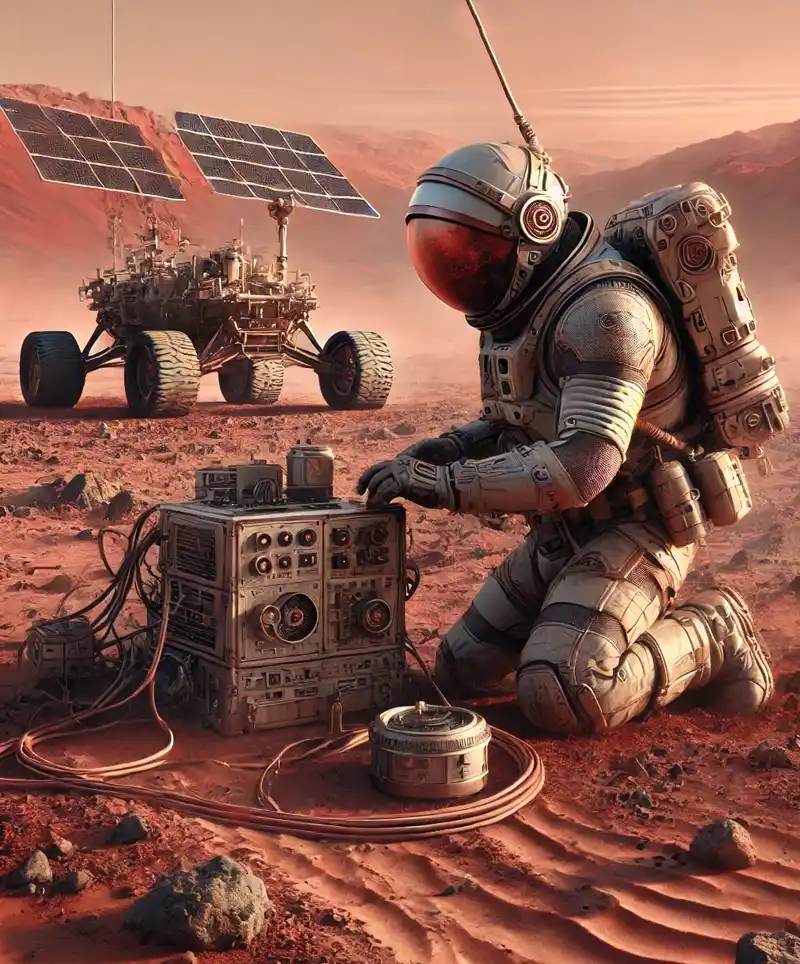The Red Planet in All Its Glory
Mars, the celestial body that inspires equal parts scientific curiosity and the odd bout of Martian paranoia. Known as the "Red Planet" for its fiery, rust-colored surface, this fourth rock from the sun has been the subject of fascination since ancient times. Celebrated on Red Planet Day, November 28, Mars deserves its moment in the sun—or at least in Earth’s orbit of appreciation.
Let’s take a deeper dive into this cosmic enigma, with facts, history, and a sprinkle of humor.
A Brief History of Martian Fascination
Mars has been captivating stargazers for millennia. Named after the Roman god of war, likely because of its blood-red hue, ancient astronomers had some pretty wild theories about this planet. While some cultures viewed Mars as an omen of doom, others thought it was a celestial neighbor worth befriending—assuming it wasn’t planning an interplanetary invasion.
In the late 19th century, American astronomer Percival Lowell thought he spotted "canals" on Mars, sparking public hysteria about Martians sipping tea by their intergalactic water features. Turns out, Lowell’s canals were just an optical illusion. But the dream of Martians has persisted, morphing into visions of little green men, advanced civilizations, and most recently, Matt Damon farming potatoes in "The Martian."
Mars by the Numbers
- Distance from the Sun: 142 million miles (229 million km). That’s far enough to avoid awkward family dinners but close enough for Earth to drop by every two years for a quick chat.
- Length of a Martian Day (Sol): 24 hours, 39 minutes, and 35 seconds. Practically the same as Earth, making it an ideal spot for lazy Earthlings who want a few extra minutes of sleep.
- Gravity: 37.6% of Earth’s gravity. Yes, you’d weigh less on Mars. Go ahead, have that extra slice of cake—it’s all about planning for the future.
- Moons: Two—Phobos and Deimos. They’re lumpy and tiny, resembling poorly made mashed potatoes rather than spherical beauties like our Moon.
 Mars owes its ruddy complexion to iron oxide—or, as we mortals call it, rust. Essentially, Mars is a giant, dusty, rusty desert. If you think cleaning your car is a hassle, imagine trying to keep a Martian rover spotless. NASA’s Perseverance and Curiosity rovers have been trudging through this rusty wasteland for years, valiantly dodging sandstorms and snapping selfies like true influencers.
Mars owes its ruddy complexion to iron oxide—or, as we mortals call it, rust. Essentially, Mars is a giant, dusty, rusty desert. If you think cleaning your car is a hassle, imagine trying to keep a Martian rover spotless. NASA’s Perseverance and Curiosity rovers have been trudging through this rusty wasteland for years, valiantly dodging sandstorms and snapping selfies like true influencers.
Life on Mars
The tantalizing possibility of life on Mars has captivated scientists, writers, and conspiracy theorists alike for centuries. From ancient tales of celestial beings to modern claims of alien selfies (courtesy of overactive imaginations and blurry telescope images), the notion of Martian life refuses to fade. But is it a dream fueled by wishful thinking or a realistic hypothesis grounded in science? Let’s unpack the possibilities.
The Microbial Martian Jackpot: If life ever existed on Mars, scientists believe it was microbial and likely lived billions of years ago when the planet had a much more Earth-like environment. Evidence suggests that ancient Mars had flowing rivers, lakes, and maybe even oceans. Imagine a vibrant, wet Mars, teeming with microbial life, enjoying its heyday before the planet dried up faster than your New Year's resolutions.
Today, scientists hunt for these ancient microbes like cosmic treasure hunters. They’re not expecting to find tiny Martian fishes or trees waving in the carbon dioxide breeze, but fossils of bacteria? That’s the gold standard. The Perseverance rover, equipped with a suite of tools better than any Swiss Army knife, is currently scouring the Jezero Crater for just such evidence.
Mars Today: A Hostile Host: Modern Mars isn’t what you’d call “life-friendly.” The atmosphere is 95% carbon dioxide, the surface temperature averages -81°F (-63°C), and harmful radiation from the Sun bombards the planet due to its lack of a protective magnetic field. In short, it’s the Airbnb that gets one-star reviews from all potential visitors.
However, some scientists think microbial life might still exist beneath the surface, where it’s shielded from radiation and possibly sustained by traces of water trapped underground. Think of it as the Martian equivalent of that stubborn dandelion growing between sidewalk cracks—a tiny, resilient survivor.
Martian Methane: A Cosmic Clue?: One of the most intriguing pieces of evidence supporting the possibility of current life on Mars is the detection of methane in its atmosphere. Methane is produced by both geological processes and biological activity, such as burping cows (thankfully not an issue on Mars). The sporadic presence of methane on Mars has puzzled scientists—could it be evidence of microbial life burping away beneath the surface? Or is it just the result of some ancient volcanic activity? The jury is still out, but methane keeps the hope alive.
What If We’re the Aliens?: Here’s a fun theory to bend your brain: what if Earth life originated on Mars? Some scientists speculate that early Mars, which was habitable before Earth, might have spawned life that hitchhiked to Earth on a meteorite after a Martian impact. That’s right—we might be the aliens, Martian immigrants who traded a rusty desert world for this lush blue planet. If true, we owe Mars a thank-you note and maybe a fruit basket.
What Finding Life Would Mean: Discovering life on Mars, past or present, would be one of the most significant scientific breakthroughs in history. It would confirm that life isn’t exclusive to Earth, shattering the belief that we’re alone in the universe. Even microbial life would answer profound questions about biology, evolution, and the possibilities for life elsewhere in the cosmos.
But it also raises ethical dilemmas. If life does exist on Mars, what happens when humans arrive? Should we protect Martian microbes at all costs, or would they be considered pests in the way of human colonization? Suddenly, those harmless little Martian bacteria could find themselves at the center of an interplanetary debate.
In the Absence of Life, There’s Always Hope: Even if Mars turns out to be lifeless, the search itself is invaluable. Every soil sample, methane detection, and rover selfie brings us closer to understanding the broader question of life in the universe. It fuels our curiosity and reminds us of the incredible resilience of life—on Earth and potentially beyond.
So, dream or delusion? The jury’s still out, but one thing is certain: Mars keeps us looking up at the stars, wondering if someone—or something—might just be looking back.

The Martian Weather Report
If you thought Earth’s weather was unpredictable, meet Mars. With an average temperature of -81°F (-63°C), the Red Planet is not exactly beach-friendly. Mars is home to colossal dust storms that can engulf the entire planet for months. Forget umbrellas—you’d need a full spacesuit and a bunker.
Mars also boasts the tallest volcano in the solar system, Olympus Mons, which is 13.6 miles high—about three times the height of Mount Everest. This is the kind of mountain that makes your neighborhood hiking trails look like molehills.
Humans on Mars
The idea of humans setting foot on Mars has gone from the pages of science fiction to legitimate plans on drawing boards across the globe. NASA, SpaceX, and a handful of other organizations are in a heated interplanetary race to make humanity a two-planet species. Why Mars? Because Venus is hotter than your aunt's casserole dish, and the Moon just doesn’t have the real estate potential we’re after.
The Dream of Colonization: Elon Musk, founder of SpaceX, envisions a bustling Martian metropolis complete with solar-powered homes, underground greenhouses, and—knowing Musk—some kind of subscription-based Mars Club for the elite. The idea is to make Mars self-sustaining so humans could live there permanently. Musk has even floated the idea of terraforming the planet, possibly by detonating nuclear devices over its polar ice caps to release carbon dioxide into the atmosphere. It’s bold, a little scary, and definitely not the plot of a supervillain movie. Probably.
NASA's Approach: NASA, meanwhile, is taking a more measured approach. Their Artemis program, currently focused on lunar exploration, is laying the groundwork for the technology and infrastructure needed to eventually make the Mars leap. This includes testing habitats, rovers, and life-support systems that can survive the planet’s extreme conditions. The ultimate goal? A crewed mission to Mars in the 2030s, assuming the budget doesn’t get cut to fund something more pressing, like another moon rover to scoop dirt.
What Makes Mars So Hard?
Let’s be clear: surviving on Mars isn’t just a weekend camping trip. The trip itself is no small feat—a seven-month journey through deep space, during which astronauts will face boredom, cramped quarters, and cosmic radiation that could make a tanning bed look like child’s play. Upon arrival, there’s no welcome mat or fully stocked pantry. Astronauts will have to contend with temperatures that make Antarctica seem tropical, a thin atmosphere composed mostly of carbon dioxide, and dust storms that could bury their shiny new habitats faster than you can say "Martian real estate."
Once humans land, everything—everything—must be done from scratch. Need water? Melt ice or extract it from the soil. Want to breathe? Bring your own oxygen or develop a way to split it from Mars’s sparse carbon dioxide. Hungry? Hope you enjoy a diet of lab-grown protein bars and hydroponic kale because that's the Martian menu for now. And don’t forget to watch your step—one wrong move in those low-gravity conditions, and you’re bouncing across the landscape like an overexcited pogo stick.
The Big Why: So why go to all this trouble? The reasons range from noble (ensuring the survival of the human race) to practical (establishing a backup plan in case Earth goes belly-up) to sheer curiosity (because humans just have to know what’s over the next hill—or planet). It’s also about proving that humanity can work together to achieve something monumental, much like the Moon landing, but on an exponentially larger scale.
Of course, there’s also the bragging rights. The first nation or organization to plant a flag on Mars will get a footnote in every history book ever written—and maybe a few extra points in interstellar diplomacy. Imagine Earthlings in the distant future explaining to aliens that the United States, China, or SpaceX beat them to Mars. It’s the ultimate humblebrag.
One Small Step, Many Giant Leaps: Humanity’s first steps on Mars, whenever they happen, will mark the beginning of an unprecedented era of exploration. From there, who knows? We might unlock the secrets of ancient Martian life, discover resources that change the game for space travel, or find out that Martian dust is terrible for our hair. Whatever happens, the journey to Mars will redefine what it means to be human—a species that simply refuses to stay put.
Celebrating Red Planet Day
So how does one properly honor Mars on Red Planet Day? Here are some fun ideas:
- Gaze at the Night Sky: Mars is visible to the naked eye when it’s closest to Earth. Look for the fiery dot in the heavens and make a wish—or plot your Martian takeover.
- Bake a Martian Treat: Whip up some red velvet cupcakes and pretend they’re Martian soil samples. Bonus points if you serve them with a side of freeze-dried astronaut ice cream.
- Watch a Mars-Themed Movie: From The Martian to Total Recall, there’s no shortage of cinematic tributes to the Red Planet. Just don’t blame Mars if the science is a little…creative.
- Build a Lego Rover: Channel your inner NASA engineer and construct your own rover. Extra points for functionality (or, you know, wheels that roll).
 Fun Martian Facts to Impress Your Friends
Fun Martian Facts to Impress Your Friends
- A year on Mars lasts 687 Earth days, which means you’d age slower. Who needs Botox when you have Martian time?
- The planet’s atmosphere is 95% carbon dioxide, making it perfect for growing space kale (assuming we ever figure out how to grow space kale).
- Mars once had flowing water, suggesting it could have supported life—if only it hadn’t turned into a giant freezer.
Mars, with all its mysteries, challenges, and quirks, continues to capture the human imagination. Whether it’s scientists planning missions, writers dreaming of Martian civilizations, or enthusiasts celebrating Red Planet Day, this little rusty neighbor of ours keeps us looking up at the night sky with wonder.
So, here’s to Mars—the planet of dreams, science, and maybe, one day, a new home for humanity. Until then, let’s enjoy it from afar—no spacesuit required.
Please Share our Content






 Mars owes its ruddy complexion to iron oxide—or, as we mortals call it, rust. Essentially, Mars is a giant, dusty, rusty desert. If you think cleaning your car is a hassle, imagine trying to keep a Martian rover spotless. NASA’s Perseverance and Curiosity rovers have been trudging through this rusty wasteland for years, valiantly dodging sandstorms and snapping selfies like true influencers.
Mars owes its ruddy complexion to iron oxide—or, as we mortals call it, rust. Essentially, Mars is a giant, dusty, rusty desert. If you think cleaning your car is a hassle, imagine trying to keep a Martian rover spotless. NASA’s Perseverance and Curiosity rovers have been trudging through this rusty wasteland for years, valiantly dodging sandstorms and snapping selfies like true influencers.
 Fun Martian Facts to Impress Your Friends
Fun Martian Facts to Impress Your Friends








 "Sláinte!" is a traditional Irish expression used as a toast, equivalent to "Cheers!" in English.
"Sláinte!" is a traditional Irish expression used as a toast, equivalent to "Cheers!" in English.